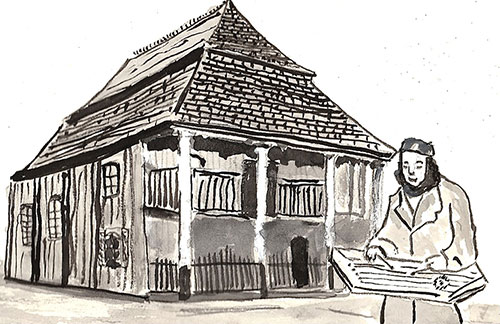Lost Treasures: The Wooden Synagogues of Eastern Europe The Artwork of Bill Farran
Mogielnica, Poland - Sumi-e Style Brush Painting
Mogielnica, Poland - Sumi-e Style Brush Painting
Yiddish: Mogelnitza
The first mention of Jews settling in Mogielnica was in 1777. By the middle of the 19th century most of the town was Jewish.
In 1828, Chaim Meir Jechiel Szapira, who was descended from an important Hasidic rabbinical family, established a yeshiva in the shtetl. His yeshiva attracted hundreds of Hasidic pilgrims into the town and in turn contributed to its economic development. In the mid-19th century, a beautiful wooden synagogue was constructed in Mogielnica.
During World War I, as the Russians were retreating from the advancing German Army, fearing that the Jews would be loyal to Germany, they expelled the entire Jewish population of five thousand Jews. After the war ended some Jews returned to Mogielnica.
The Germans seized Mogielnica on September 8, 1939. On the same day they burned down the wooden synagogue. In October 1939 they established the Judenrat which had to supply the Nazis with forced labor. On February 27 and 28, 1942, fifteen hundred Jews from Mogielnica were transported to the Warsaw Ghetto. There they were beaten, worked, and starved the death. Many were transported to the Treblinka Death Camp. On April 19, 1943, the Germans sent in tanks and heavy equipment to liquidate the Warsaw ghetto, The poorly armed Jews revolted and battled Germans until they were finally defeated on May 16, 1943.
